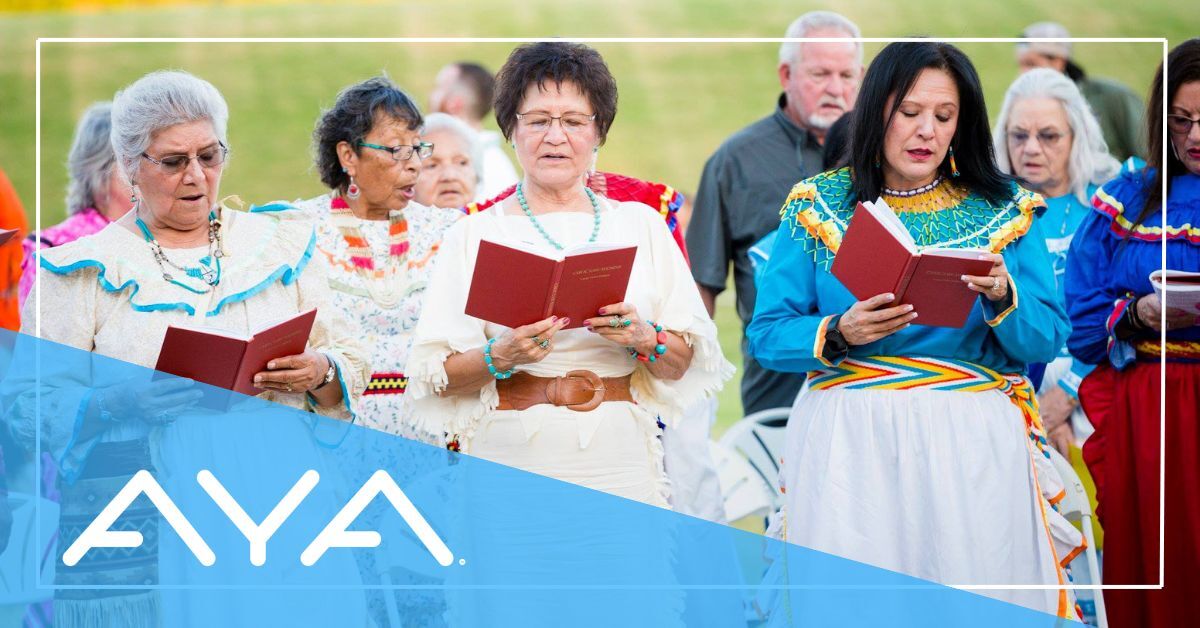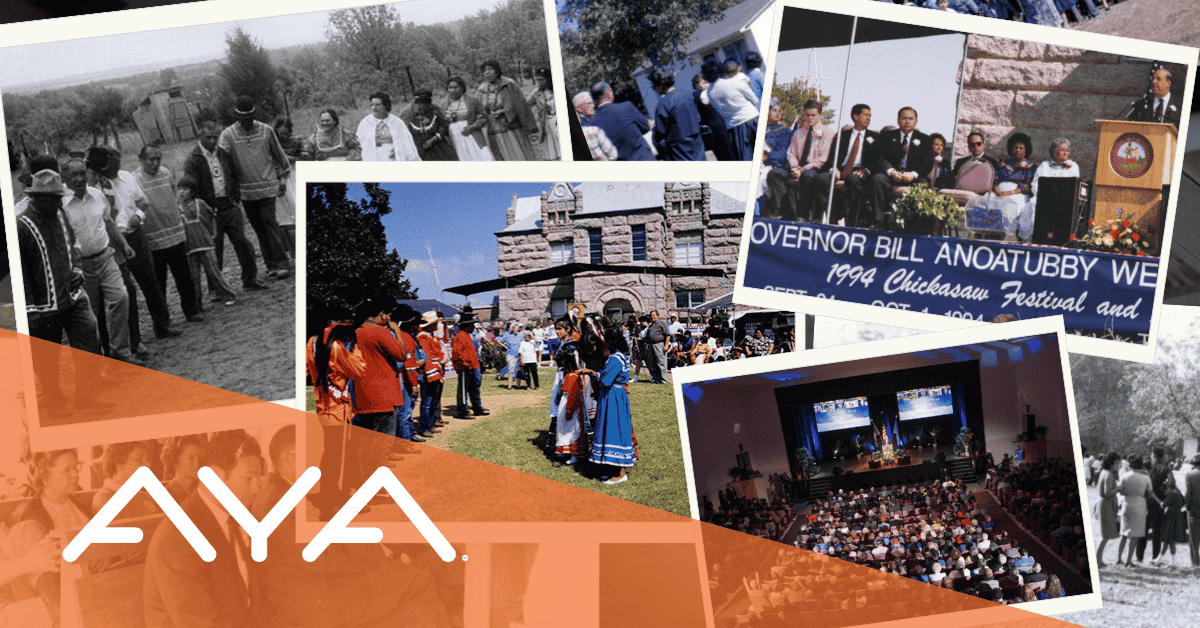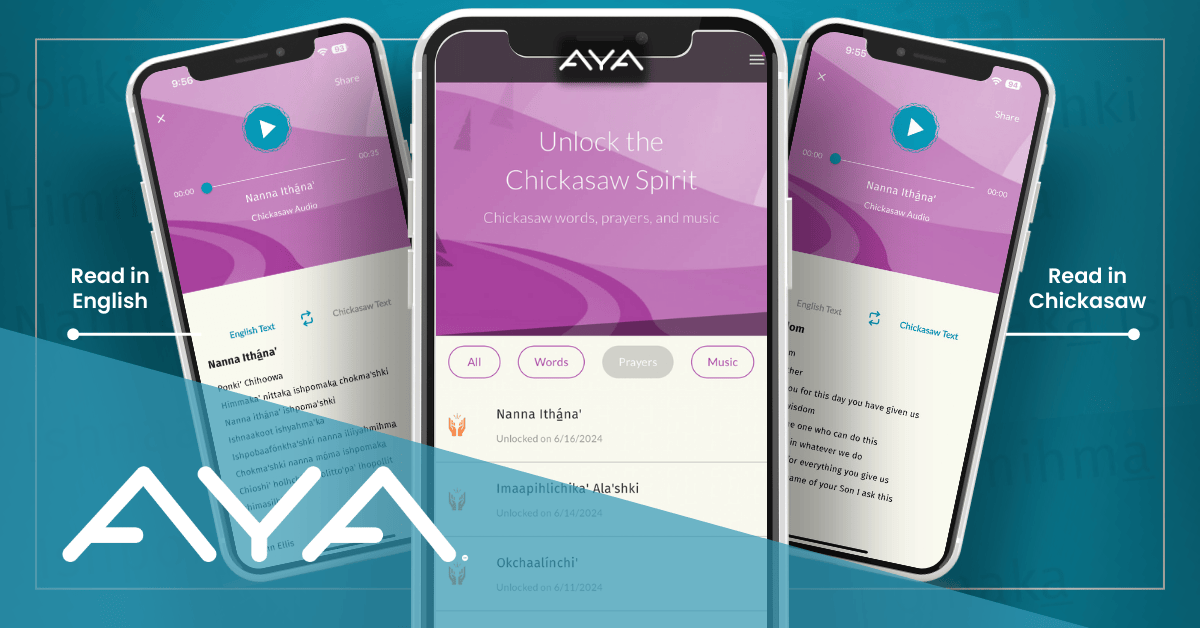Chickasaw Annual Meeting and Festival: A Journey Through Time and Tradition
Ever wondered how the Chickasaw Annual Meeting and Festival became such an important tradition? It is a story of resilience, unity and pride. In...

Table of Contents
The story of shared language, faith and cultural preservation through sacred music.
If you have ever heard Choctaw hymns sung at a Chickasaw gathering, you have witnessed something profound: the living expression of cultural kinship that transcends tribal boundaries. The answer to “why Chickasaws sing Choctaw hymns” unfolds like the songs themselves — through history, language and the enduring strength of two strong nations.
This tradition began more than 200 years ago and continues today through digital preservation efforts like the AYA Walk app. Understanding this story reveals not just historical facts, but the remarkable ways tribal communities preserved their heritage through song.
In 1819, missionaries arrived in the Choctaw Nation at the invitation of Chiefs Mushulatubbee and David Folsom. What the Choctaw Nation accomplished next would forever change the landscape of First American sacred music in the Southeast. Rather than accept English-only worship leaders, Choctaw leaders and missionaries made a transformative decision: they would create religious materials in the Choctaw language.
Working alongside missionaries, Choctaw leaders created a writing system, compiled dictionaries and translated scripture and hymns. More significantly, Choctaws who converted to Christianity began preaching and composing original hymns in their native language, ensuring that the Christian faith could be expressed through Choctaw cultural understanding.
The first Choctaw hymnal appeared in 1829 with 55 hymns and five doxologies (short hymns of praise). By 1850, the core hymn collection familiar to congregations today was complete. The timing proved crucial as these hymns were created during one of the most challenging periods in First American history.
Several hymn translators and composers were Choctaw men who faced Removal, and the monumental task of rebuilding communities in Indian Territory. Leaders such as David Folsom, Capt. Joseph Dukes and Israel Folsom channeled their experiences of loss, hope and resilience into melodies and words that continue to resonate almost two centuries later.
The Choctaw Nation's creation of these hymns served dual purposes that would prove essential for the Chickasaw Nation: they preserved Choctaw language in written form and provided spiritual comfort during cultural upheaval.
The reason Chickasaws could seamlessly adopt these Choctaw hymns lies in the deep linguistic connection between our two tribal languages. While Chikashshanompa’ (the Chickasaw language) did not have a formal writing system until the 20th century, the first Choctaw hymnal was published in 1829.
This timing created an opportunity, but linguistic kinship made it possible. The Chickasaw and Choctaw languages share deep roots — some estimate up to an 80% overlap in vocabulary and grammatical structures.
This connection becomes clear in the phrase "Choctaw hymns" itself. Chickasaws say Taloa Chata while Choctaws say Chahta ʋba isht taloa. The word Taloa means "to sing" in both languages. Chata and Chahta represent different versions of "Choctaw." Even Anompa (in Chickasaw) and Anumpa (in Choctaw) are nearly identical, both meaning "language."
This linguistic relationship meant that when Chickasaw congregations encountered Choctaw hymns, they were not learning foreign songs — they were hearing familiar sounds with recognizable meanings. The grammar patterns, root words and pronunciation rhythms aligned closely enough that Chickasaw speakers could participate meaningfully in Choctaw hymn singing.
For Chickasaw churches seeking written religious materials, the Choctaw Nation's hymnal provided an immediate and welcomed solution. Rather than waiting for Chickasaw-language hymns to be composed and published, our congregations could adopt the existing Choctaw hymnal while maintaining native language worship.
Choctaw hymns gained profound significance in Chickasaw communities through their role during critical historical moments. Two hymns particularly demonstrate this deep integration:
Hymn 112, "Meditation on Death," holds special meaning in Chickasaw oral history. Tribal accounts recall that our ancestors sang this Choctaw hymn during Removal. The words carry a profound sense of loss yet offer hope for a better future in a heavenly land with God, themes that spoke directly to Chickasaw families facing forced relocation and uncertain futures.
Hymn 48, "Prayer to the Holy Spirit," became another cornerstone of Chickasaw worship, often sung to the familiar tune of "Amazing Grace." Its message pleads with the Holy Spirit to comfort a suffering people and bring happiness and peace. Words that resonated powerfully with communities rebuilding their lives in Indian Territory.
Beyond their spiritual significance, these Choctaw hymns served a crucial cultural preservation function for the Chickasaw Nation. As documented in Chickasaw.TV's “Elders Speak" series, during the era of government boarding schools and English-only policies, Chickasaw churches provided sanctuary for native language use. While children faced punishment for speaking Chickasaw or Choctaw in schools, Sunday worship remained a space where tribal languages flourished through the singing of Choctaw hymns.
Church services were all-day community events where families gathered, socialized and worshiped together. Geneva Holmon, a Chickasaw elder interviewed in “Elders Speak," captured the centrality of these hymns in her childhood with four simple words: "That's all we sang."
Her statement reveals how completely Choctaw hymns had integrated into Chickasaw religious and cultural life. For her generation and many others, the Choctaw hymns were not just music. They were expressions of community, language and connection during periods when external forces pressured Indigenous communities to abandon First American practices.
This living tradition continues through modern preservation efforts that honor both its historical significance and ongoing cultural relevance. In February 2024, AYA partnered with the women's chorus of Mitchell Memorial United Methodist Church in Ada to record 15 hymns for the AYA Walk app.
Fifteen First American women, many of them Chickasaw, gathered to lend their voices: Jessica Bevins, Gina Brown, LaDonna Brown, Pat Greenwood Cox, Abigail Farve Brown, Arielle Farve Deer, Carol Shields Fox, Rose Jefferson, Mary L. Johnson, Julienne Elaine Judd, Eula M. Lufkin, Suzanne Russell, Mary Jane Frazier Smith, Gina Teel and Laura Elizabeth Williams.
Their participation represents generations of cultural stewardship. Mary L. Johnson is the granddaughter of the Rev. Jesse Humes, co-compiler of A Chickasaw Dictionary. Pat Greenwood Cox's mother, Geraldine Factor Greenwood, developed an early Chickasaw language curriculum. Gina and LaDonna Brown are daughters of Pauline Brown, who was a fluent Chickasaw speaker and Chickasaw Language Committee member, and Mary Jane Frazier Smith’s husband, Stanley Smith, was a fluent speaker of the Chickasaw language who played a key role in the Chickasaw Nation’s Master-Apprentice program, working to revitalize the Chickasaw language.
These 2024 recordings join earlier preservation efforts, including recordings made in 1993 at Boiling Springs United Methodist Church. Today, the AYA Walk app offers more than 40 hymns, some with renditions from both recording sessions, allowing listeners to hear how the same sacred songs live differently across Chickasaw and Choctaw communities while maintaining their essential spiritual and cultural functions.
Understanding why Chickasaws sing Choctaw hymns becomes more meaningful through personal engagement with this musical heritage. The language similarities that made these hymns accessible to 19th-century Chickasaw congregations continue to benefit us today.
You do not need fluency to begin. By listening, humming or singing along, you join a living chorus linking past and future. The older hymns in the app are sung without accompaniment to the traditional tunes that have been passed down through the generations. Each note strengthens cultural ties and honors those who came before us.
Research confirms that music supports language learning. Studies show that hearing songs or hymns in a target language can sharpen pronunciation, rhythm and listening comprehension. Even though these hymns are in Choctaw, the similarities with Chickasaw make them valuable tools for language learning and cultural connection.
How to Begin:
How to Access the Hymns:
Visit our Mindfulness Guide on AYA Walk News for a step-by-step guide and how-to video.
Once in the Mindfulness section in the AYA Walk app, you can select "music" to filter out movement and meditation videos to browse only the hymn collection. Each hymn is listed by its number with a description of its history and cultural significance.
As a companion to the audio recordings in AYA, you can view the text of the hymns in the Choctaw Hymns app. This app offers a selection of popular Choctaw hymns from the print version of the Choctaw Hymn Book and is available in the App Store or Google Play.
The question "Why do Chickasaws sing Choctaw hymns?" finds its answer in the intersection of history, language and cultural resilience. When Choctaw leaders created the first written hymnal, they provided neighboring tribal communities with sacred music that felt both familiar and meaningful.
The 80% linguistic overlap between Chickasaw and Choctaw languages made adoption natural. The hymns' role during Removal and as cultural sanctuary during assimilation pressure made them essential. Their preservation through contemporary recording efforts makes them accessible to new generations seeking connection to their heritage.
Today, when Chickasaws sing Choctaw hymns, they participate in an unbroken tradition of tribal language preservation, spiritual expression and intertribal connection. Every voice that rises in these ancient melodies, whether in traditional church services or through smartphone apps, continues a conversation that began with chiefs and leaders who survived Removal and suppression and now bridges past and future through the power of song.
The hymns endure because they serve the same functions they have fulfilled for nearly two centuries: connecting communities to ancestral languages, preserving cultural memory and providing spiritual expression rooted in First American experience. They represent more than musical adoption. They demonstrate how we maintained our cultural bonds across political boundaries and historical challenges.
Every time you listen to these hymns, you honor the Choctaw composers who channeled their experiences of loss and hope into lasting melodies, you connect with the Chickasaw congregations who found sanctuary in these hymns and you join the contemporary voices working to ensure these songs reach future generations.
Chokma’shki, and welcome to the chorus,
The AYA Walk Team
References
The Chickasaw Nation. (n.d.). Language. https://chickasaw.net/Our-Nation/Culture/Language.aspx
The Chickasaw Nation. (2021, September 30). Hymn Singing Presentation [Video]. https://www.facebook.com/share/v/1D8BPvXwpi/
Chickasaw Times. (2018, February). Choctaw Hymnal App Now Available. https://www.chickasawtimes.net/Web-Exclusives/Choctaw-Hymnal-app-now-available.aspx
Chickasaw.TV. (n.d.). First Social Network | Elders Speak S3 • E2 [Video]. https://www.chickasaw.tv/episodes/elders-speak-season-3-episode-2-first-social-network
Chickasaw.TV. (n.d.). Kullihoma | Elders Speak S3 • E1 [Video]. https://www.chickasaw.tv/episodes/elders-speak-season-3-episode-1-kullihoma
Guest, Charlotte. (2023, May 12). Can music help you learn languages? https://www.pearson.com/languages/community/blogs/2023/05/can-music-help-you-learn-a-language.html
Iti Fabʋssa. (2014, February). Chahta Vba Isht Taloa: The Choctaw Hymns. https://choctawnationculture.com/media/32783/2014.02%20The%20Choctaw%20Hymns.pdf
The AYA Walk App is a one-of-a-kind step counter that offers an exciting way to discover captivating narratives as you go about your daily routine.
The word "AYA" originates from the Chickasaw language and signifies "to go; to journey." As you take steps towards improving your fitness, AYA Walk accompanies you on this adventure, guiding you through time and unlocking stories from the past.
Along the way, you will stumble upon hidden treasures rooted in Chickasaw heritage, discover historical paths that unveil the secrets of the past, and have the chance to listen to stories about significant cultural landmarks.
AYA Walk celebrates more than just physical well-being; it also fosters a renewed connection to a healthier lifestyle. By engaging with this innovative step tracker, you'll improve your fitness and gain a deeper appreciation for the stories surrounding us.
Download AYA Walk today!

Ever wondered how the Chickasaw Annual Meeting and Festival became such an important tradition? It is a story of resilience, unity and pride. In...

The traditional sport of Chickasaw stickball, often called the "little brother of war," is far more than a game. For the Chickasaw Nation, stickball...

Learn about the role of prayer in Chickasaw culture and how you can hear (and learn) prayers in the Chickasaw language.